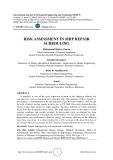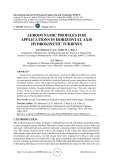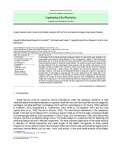
http://www.iaeme.com/IJMET/index.asp 1373 editor@iaeme.com
International Journal of Mechanical Engineering and Technology (IJMET)
Volume 10, Issue 03, March 2019, pp. 1373-1383. Article ID: IJMET_10_03_138
Available online at http://www.iaeme.com/ijmet/issues.asp?JType=IJMET&VType=10&IType=3
ISSN Print: 0976-6340 and ISSN Online: 0976-6359
© IAEME Publication Scopus Indexed
PERFORMANCE ANALYSIS OF TURBINE
VENTILATORS FOR REFUGEE CAMPS USAGE
M. I. N. Ma’arof
Department of Mechanical Engineering, INTI International University, Persiaran Perdana
BBN, Putra Nilai, 71800 Nilai, Negeri Sembilan, Malaysia
Girma T. Chala
Department of Mechanical (Well) Engineering, International College of Engineering and
Management, P.O. Box 2511, C.P.O Seeb 111, Sultanate of Oman
Shree R. Nair
Department of Mechanical Engineering, INTI International University, Persiaran Perdana
BBN, Putra Nilai, 71800 Nilai, Negeri Sembilan, Malaysia
ABSTRACT
A turbine ventilator is a promising technology used to achieve multiple cooling
conditions. The present study proposed a method to improve the indoor air quality (IAQ)
of refugee camps to overcome issues related to air borne diseases. A turbine ventilator
was designed based on the ISO and ASHRAE standards. The effect of the turbine
ventilation fan on the IAQ of a modelled refugee shelter was investigated via
Computational Fluid Dynamics (CFD) simulation. The first part of the study was
intended to select the best turbine ventilator design to test its performance while in the
second part, simulation study was conducted on the selected design in comparison with
the benchmarks (currently market-available turbine ventilators). It was observed that a
55° blade angle design performed best at 115 RPM and was tested for indoor air quality
improvement for the transitional shelter found in the Dadaab region, Kenya. ISO 7730
(2005) standards were met with average internal air velocity of 0.25m/s. PMV and PPD
for the whole space were at 0.452 and 9.938%, respectively, which are well within the
recommended values. The results from this study would hopefully provide an insight
into future developments of turbine ventilators not only for refugee camps, but also for
other sectors requiring improvements to indoor air quality.
Keywords: Turbine ventilator, Performance, Percentage of dissatisfied, Refugee camps.
Cite this Article: M. I. N. Ma’arof, Girma T. Chala and Shree R. Nair, Performance
Analysis of Turbine Ventilators for Refugee Camps Usage, International Journal of
Mechanical Engineering and Technology, 10(3), 2019, pp. 1373-1383.
http://www.iaeme.com/IJMET/issues.asp?JType=IJMET&VType=10&IType=3

M. I. N. Ma’arof, Girma T. Chala and Shree R. Nair
http://www.iaeme.com/IJMET/index.asp 1374 editor@iaeme.com
1. INTRODUCTION
Refugee camps in some places have not been getting sufficient attentions when it comes to
indoor air quality and ventilation. The influx of refugees creates overpopulation and does not
help reduce the spread of diseases, such as tuberculosis and influenza viruses. Over the years,
the majority of refugee resides in the Dadaab region, Kenya where an estimate of 425,938
refugees are registered. The Kenya Ministry of health established nationwide facilities based
on the spread of influenza pandemic in 2006, where the camps of Kakuma and Dadaab being
the main targets [1]. Indoor air quality (IAQ) encompasses the structure and its surroundings
and its assessment is based on the level of health and comfort of the occupants. Chianga and
Laib [2] discussed that the indoor environment is complex and dependent on many factors. The
main factors rely on identifying the air contaminant sources and proposing proper ventilation.
Although not well documented, the effects of airborne contaminants towards deteriorating
human health in the African region were brought to light in the studies conducted by [3].
Consequently, in tight and packed spaces like the refugee camps of Dadaab, Kenya, the chance
of these contaminations spreading and affecting the rest of the camp is high, if proper care is
not put in place. The main purpose of ventilation in regard to air quality lies in its ability to
transport out pollutants and contaminated air [4]. A review on different designs of wind driven
natural and hybrid ventilation systems yielded that turbine ventilators are the best option when
cost, performance and construction are concerned [5]. The same study also presented arguments
supporting the fact that turbine ventilators are the ideal choice considering its size and its ability
to maintain humidity and reduce the accumulation of contaminants and pollutants in the air.
A turbine ventilator, also known as rotary ventilator, operates on the basic principles of
buoyancy. As the air in the room of a structure rises, the stack effect allows the pressure
differences between indoor and outdoor air to escape the structure into the surroundings.
However, the fan in the turbine ventilator aids the process by utilizing a suction effect through
the negative pressure that is created in the process of the spinning aero foil vanes, driving air
out from the structure into the surrounding air [6]. The performance of the ventilators depends
on the surrounding wind speed, the design of the vanes and also the way it is installed onto the
roof, among other factors. Wang and Shen [7] concluded that the mass flow rates of the air are
directly correlated with the pitch angle of the roof. Lien and Ahmed [8]; however, concluded
that the rotational speed of a turbine can be increased by increasing the inclination of the roof.
It was also observed that air change rate changes with the variation in wind direction. A change
from 0° to 45° declined the air change rate by 10% [9].
Flynn and Ahmed [10] stated that larger diameter ventilators performed better with better
extraction rates. This was backed by Lai [11], who discovered that smaller diameter turbine
ventilators performed worst when compared to their larger counterparts. In terms of blade
design, Revel [12] found that the straight vane turbine is more effective at air extraction as
opposed to the curved vane turbine design. They also observed that the larger 300 mm diameter
throat turbine ventilator outperformed the smaller 250 mm diameter throat. West [13] discussed
that the flow rate of a straight vane turbine ventilator can be increased by 13.5% by increasing
its blade or vane height by 50%. A CFD studies by Lien and Ahmed [8] showed that the
performance metrics meet the general requirements and standards of indoor air quality for a
modeled living room. Kuo and Lai [14] showed that the lower pressure caused by the turbine
ventilator aids in reducing odor leakage to other parts in the building while maintaining
sufficient air change rates.
There seems to be little evidence to prove the effect of ventilations on reducing the spread
of infections in a structure. Studies have been conducted to determine the cause and
transmission of diseases; however, the impact of ventilation on reducing the transmission of
airborne diseases remains to be properly researched. The objective of this study was, therefore,

Performance Analysis of Turbine Ventilators for Refugee Camps Usage
http://www.iaeme.com/IJMET/index.asp 1375 editor@iaeme.com
to test the different designs of turbine ventilator to improve the air indoor air quality (IAQ) of
refugee camps in Africa to overcome issues related to air borne diseases. This would provide
an insight towards the significance and viability of using wind turbine ventilator, and
subsequently it can be implemented in more refugee camps.
2. MATERIALS AND METHODS
The turbine ventilator was designed to meet the recommended ventilation rate standards for
good indoor air quality. These standards are included in ventilation standards, such as American
Society of Refrigerating and Air-Conditioning Engineers ANSI/ASHRAE standard 62 and ISO
Standard 7730 [15, 16]. These standards for residential and public buildings do not particularly
give a standard for refugee camps. Therefore, an estimation was taken into account based on
the standard values of a recommended 4-8 air changes per hour (ACH) for different volumes
of residential building and rooms. The mechanical ventilation rate required was then determined
using the equation below:
𝑄𝑣𝑒𝑛𝑡 = 𝑛 × 𝑉
𝑠ℎ𝑒𝑙𝑡𝑒𝑟 (1)
Where:
𝑛 is the air change rate per hour (ACH)
𝑉
𝑠ℎ𝑒𝑙𝑡𝑒𝑟 is the volume of the shelter (𝑚3)
𝑄𝑣𝑒𝑛𝑡 is the ventilation rate (𝑚3/ℎ)
The maximum recorded extraction rate or ventilation rate is calculated as follows:
𝑄𝑣𝑒𝑛𝑡 = 𝐴𝑡ℎ𝑟𝑜𝑎𝑡 × 𝑉
𝑝𝑜𝑖𝑛𝑡 × 3600 (2)
Where: 𝐴𝑡ℎ𝑟𝑜𝑎𝑡 is the throat area of the turbine ventilator (𝑚2), 𝑉
𝑝𝑜𝑖𝑛𝑡 is the velocity at the
point (𝑚/𝑠) and 𝑄𝑣𝑒𝑛𝑡 is the ventilation rate (𝑚3/ℎ)
A target ventilation rate for the transitional shelter design with a volume of 83.64 m^3 and
an air change rate of 8 ACH will have a value of 669.12 (m^3/h). However, the ASHRAE
standards for recommended air changes per hour can be higher or lower depending on the
occupancy. To categorize refugee camps under residential conditions is not the best solution
but for the purpose of this study, the turbine ventilator was made to achieve a ventilation rates
greater than 669.12 (m^3/h). Following suit, the ISO 7730 standards for indoor comfort relies
on several aspects: temperature, indoor air velocity, humidity being the main parameters. To
achieve a comfort level of 80% acceptance for the turbine ventilator, the results from the CFD
simulation have to be within acceptable range of these comfort variable benchmarks: room
temperature in the range of 24˚C - 26˚C, indoor air velocity < 0.25 m/s, Predicted Mean Vote
(PMV) of -0.5 – 0.5 and Predicted Percentage of Dissatisfied (PPD) ≤ 10%
3. TRANSITIONAL SHELTER MODEL GEOMETRY
The transitional shelter design selected for this study was the compact bamboo shelter design.
The roof inclination and materials were not taken into account when modelling the shelter in
SolidWorks. Figures 1 and 2 show the front elevation of compact bamboo T-shelter and the
isometric view of the modeled T-shelter, respectively. Table 1 shows the dimensions of the
modelled T-Shelter.

M. I. N. Ma’arof, Girma T. Chala and Shree R. Nair
http://www.iaeme.com/IJMET/index.asp 1376 editor@iaeme.com
Figure 1 Front elevation of compact bamboo T-Shelter
(UNHCR Shelter Design Catalogue, 2016) [16].
Figure 2 Isometric view of the modeled T-Shelter (Dimensions in mm).
Table 1 shows the dimensions of the modelled T-shelter.
Shelter length (𝑚)
6.0
Shelter Width (𝑚)
4.1
Shelter Height (𝑚)
3.4
Shelter Volume (𝑚3)
83.64
Wall Thickness (𝑚)
0.15
Ceiling hole diameter (𝑚)
0.462
Window length (𝑚)
0.6
Window Height (𝑚)
0.6
4. TURBINE VENTILATOR DESIGN GEOMETRY
The performance metrics of these ventilators are studied based on previous studies by Revel
[12] and West [13]. The straight vane turbine ventilator design, shown in Figure 3, was chosen
due its superior performance. The turbine ventilator design is inspired by the two models from

Performance Analysis of Turbine Ventilators for Refugee Camps Usage
http://www.iaeme.com/IJMET/index.asp 1377 editor@iaeme.com
Edmonds Hurricane line of products [18]. The dimensions of the turbine ventilator for the
shelter are based on the H400 and H450 model. The number of blades were set to 24 to match
the standard designs of the Edmonds ventilators. Three designs were tested with blade angles
at 45˚, 55˚ and 65˚.
Figure 3 Straight vane turbine ventilator design (Dimensions in mm).
5. WIND TUNNEL GEOMETRY
A wind tunnel structure was designed in CAD to simulate the wind velocities. The wind tunnel
aids in even distribution of uniform air flow to the ventilator at higher wind speeds. The wind
tunnel is setup on top of the shelter model in the simulations, enclosing the turbine ventilator
6. NUMERICAL MODELLING
SolidWorks flow simulation package was used for this study. Due to the dependency on mesh
settings, boundary conditions and turbulence models of CFD testing, the settings used are
detailed in this section. In SolidWorks Flow Simulation, the turbulence model used is the k-
epsilon (k-ε) model. However, to calculate the transient flows, the local rotating regions
(Averaging) option was used to select a rotating body. The meshing was done through a
Cartesian meshing method. The mesh setting was done using the global automatic mesh
method, maximum level 7 initial mesh level, with advance channel refinement option turned
on.
Figure 4 shows boundary conditions and set up of the turbine ventilator. To set up the
internal flow analysis, first, the geometry must first be sealed to be “water-tight” for SolidWorks
to define the boundary conditions. The conditions are then set accordingly. Inlet velocity was
set as 7m/s according to the climate data of Dadaab, Kenya. Temperature was set as default at
20.5˚C as the temperature parameters are not of concern for the initial performance testing of
the different blade angles of the turbine ventilator. Environment pressure of 101325 Pascals or
1 atmosphere is set as a boundary condition at the exit of the wind tunnel as well as the small
window in the shelter model.




![Tài liệu học tập Hệ thống điều khiển điện - khí nén và thủy lực [mới nhất]](https://cdn.tailieu.vn/images/document/thumbnail/2021/20211005/conbongungoc09/135x160/811633401135.jpg)
![Tính chọn lắp ghép tiêu chuẩn giữa áo trục và trục chân vịt tàu thủy [chuẩn nhất]](https://cdn.tailieu.vn/images/document/thumbnail/2021/20210219/caygaocaolon10/135x160/5291613732560.jpg)


















![Đề cương đề tài nghiên cứu khoa học [chuẩn nhất/mới nhất]](https://cdn.tailieu.vn/images/document/thumbnail/2025/20251117/duong297/135x160/26111763433948.jpg)

